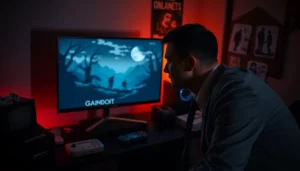Table of Contents
ToggleIn a world where mainstream horror games dominate the scene, indie horror games are the quirky underdogs ready to steal the spotlight. These gems pack a punch with their unique storytelling and spine-chilling atmospheres, proving that sometimes the little guys have the most terrifying tales to tell. Forget about the predictable jump scares; indie developers are crafting experiences that linger long after the screen goes dark.
Overview of Indie Horror Games
Indie horror games represent a significant shift in the gaming landscape. They provide unique narratives that often surpass mainstream titles in emotional depth and psychological horror. Gamers frequently find these experiences more immersive due to innovative designs and creative storytelling.
Smaller development teams typically produce these games, often working with limited budgets and resources. Such constraints lead to remarkable creativity, as developers experiment with gameplay mechanics and visual styles. Success stories like “Amnesia: The Dark Descent” and “Five Nights at Freddy’s” illustrate the potential for indie titles to capture gamers’ imaginations.
Players often appreciate the unpredictability of indie horror games. Unique art styles and unconventional narratives contribute to a sense of fresh experiences. These elements often resonate with audiences, creating a loyal following.
The indie horror genre thrives on community engagement. Developers frequently interact with players through social media and game forums, fostering a collaborative environment. This accessibility encourages feedback and helps shape future projects, enhancing player investment in upcoming titles.
Innovative marketing strategies also contribute to the genre’s growth. Many indie developers utilize crowdfunding platforms to finance projects, allowing them to gauge interest and build a supporter base. As a result, they cultivate a dedicated community before the game even launches.
These aspects make indie horror games stand out in a crowded market. They breathe new life into the horror genre, allowing for imaginative expressions of fear and unease. Such contributions redefine players’ expectations and expand the boundaries of traditional horror experiences.
Popular Indie Horror Games
Indie horror games captivate players with their unique narratives and immersive atmospheres. Several titles exemplify this trend, showcasing creativity in storytelling and gameplay.
Notable Titles
“Amnesia: The Dark Descent” stands as a landmark in psychological horror. Players navigate a chilling world filled with darkness and suspense. “Five Nights at Freddy’s” redefined survival horror with its tension-filled gameplay and animatronic antagonists. “Outlast” immerses users in a terrifying asylum, emphasizing stealth and survival. “The Binding of Isaac” combines horror with roguelike mechanics, appealing to a wide range of players. These games each bring distinct elements, contributing to the genre’s diversity and popularity.
Unique Features
One notable aspect of indie horror games is their focus on narrative depth. Developers often emphasize emotional resonance and psychological themes. Unique art styles set these titles apart, with many opting for hand-drawn or pixelated visuals that create a haunting atmosphere. Experimental gameplay mechanics often challenge conventional horror tropes, engaging players in unexpected ways. Community involvement shapes these games, as developers integrate player feedback into updates and new content. This connection fosters loyalty and encourages investment in future projects, enhancing the overall experience.
Development of Indie Horror Games
Indie horror games have transformed game development, allowing small teams to innovate with storytelling and gameplay.
Key Developers
Many influential developers have emerged in the indie horror scene. Team Silent, creators of “Silent Hill,” inspired countless indie developers. Frictional Games revolutionized atmospheric horror with “Amnesia: The Dark Descent,” setting a new standard for immersive storytelling. Scott Cawthon gained massive recognition through “Five Nights at Freddy’s,” blending fear with resource management. Developers like David Braben, the force behind “Elite,” have influenced game design directly. As these creators focus on psychological horror, they offer unique narratives that resonate deeply with players.
Funding and Distribution
Funding for indie horror games often comes from diverse sources. Crowdfunding platforms like Kickstarter and Indiegogo provide crucial financial support, enabling developers to bring their visions to life. Many developers also utilize grants and incubators, receiving assistance to enhance their projects. Distribution channels like Steam and itch.io facilitate reaching a broader audience, allowing players to discover new titles conveniently. Digital marketplaces empower indie developers, bypassing traditional publishing barriers and enabling innovative game experiences.
Impact on the Horror Genre
Indie horror games significantly influence the horror genre through creative approaches and unique narratives. Their ability to explore themes often overlooked in mainstream titles captivates audiences.
Innovative Storytelling
Narrative depth characterizes many indie horror games. Players encounter emotional journeys that resonate on personal levels. Frictional Games exemplifies this with “Amnesia: The Dark Descent,” where psychological horror challenges perceptions of reality. Titles like “The Binding of Isaac” present unconventional storytelling by blending horror with roguelike mechanics. Such originality often leads to fresh scares, making these narratives memorable. Developers prioritize player emotions, crafting stories that linger long after gameplay. Unique narratives diminish reliance on clichés, inviting players to engage with deeper, thought-provoking themes.
Player Experience
Immersive environments enhance player experiences in indie horror games. Unique art styles create haunting atmospheres that draw gamers into terrifying worlds. Players often spend hours exploring locations filled with tension and unease. Innovative gameplay mechanics challenge traditional horror tropes, keeping experiences unpredictable. Feedback from the community shapes updates, enriching content and loyalty among players. By providing hands-on engagement, players connect more profoundly. Titles like “Outlast” not only terrify but also foster emotional investment through character-driven experiences. Each moment in these games contributes to lasting impressions, keeping horror fans eager for more.
Future Trends in Indie Horror Games
Emerging technological advancements will likely shape the future of indie horror games significantly. Virtual reality (VR) presents opportunities for developers to create deeply immersive experiences. Game mechanics that leverage augmented reality (AR) may also enhance player engagement by blending real-world environments with horrific narratives.
Artificial intelligence (AI) is expected to play a major role in generating dynamic gameplay experiences. Developers could implement AI-driven narratives that adapt based on player choices, adding layers of complexity to storytelling. More games may incorporate procedurally generated environments, ensuring unique experiences with every playthrough.
Crowdfunding platforms continue to provide diverse funding opportunities, enabling new ideas to emerge. As indie developers tap into these resources, they will likely experiment with unconventional horror themes that resonate with dedicated fan bases. Players could see an expansion of genre-crossing titles that blend horror with other genres, such as puzzle-solving or even simulation games.
Community involvement remains crucial in shaping game development. Many developers actively seek feedback from players during the creation process, creating collaborative environments that lead to better products. Engaging communities through forums and social media will remain vital to maintain loyalty and support for indie titles.
Accessibility in gaming is also expected to influence future indie horror games. Focus on inclusivity may lead to features designed for players with disabilities, ensuring horror experiences are available to a wider audience. As game designers prioritize this aspect, the industry as a whole may evolve towards more engaging and compassionate storytelling.
Ultimately, innovations in technology, funding, community collaboration, and inclusivity will steer the evolution of indie horror games, pushing the boundaries of creativity and player experience in the genre.
Indie horror games are redefining the genre by offering fresh narratives and immersive experiences that resonate deeply with players. Their emphasis on psychological depth and innovative gameplay sets them apart from mainstream titles. As technology evolves and community involvement increases, these games are poised to explore new creative avenues and reach broader audiences.
The future looks promising for indie developers who continue to challenge conventions and push boundaries. With the potential of VR and AI, players can expect even more engaging and personalized horror experiences. This evolution ensures that indie horror will remain a vital and exciting part of the gaming landscape, captivating both new and seasoned gamers alike.







